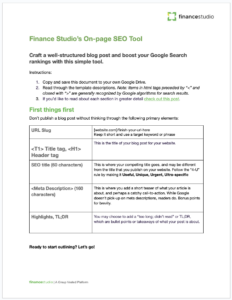Haven’t quite cracked on-page SEO, or not sure where to start?
If you want to create blog posts and web pages that capture the best organic Google search results, the tips below will help make a difference in your organic search efforts.
First, get the template tool
 To help you develop the habit of writing like a digital marketer, we’ve created a downloadable on-page SEO tool to ensure you remember all the necessary elements to get recognized by Google’s search-ranking algorithm.
To help you develop the habit of writing like a digital marketer, we’ve created a downloadable on-page SEO tool to ensure you remember all the necessary elements to get recognized by Google’s search-ranking algorithm.
It reminds you to set up your blog posts and pages with necessities, such as:
- Title
- Meta description
- Header
- Sub-headers, and lastly,
- Your call-to-action
The tool is free. Simply download the tool here (Word .docx file) then read along as we explain how it works.
Take it from the top
Let’s take a look at the template.
Some elements are preceded by a “<” and ended by “>” because that’s how they appear behind the scenes in html code and denote html “tags.”
This enables your web developer or content management system (CMS) to format them, or place them correctly. Other elements, while not formal html tags, exist primarily to help organize and structure the layout of your content to make it easier on the reader and facilitate optimal on-page SEO.
- URL slug is at the top of the Tool. This is the “suffix”, or last part of, your website domain link.
Here’s an example of what this looks like: www[dot]yourwebsite[dot]com/your-url-slug-here, and it is the live link to your article.
Most CMS platforms today, like WordPress, Squarespace, and Wix, let you customize your slug, so it’s more user-friendly than a string of numbers or a date. It’s also the first place to boost SEO, so you’ll want to include your target keyword or short keyword phrase. You can read up on URL slugs here.
- <T1> Title or <H1> Header tags designate how your title will appear on your blog, and helps humans decide if they want to read or pass. To formulate great titles, the “4-U” rule is easy to remember: Make sure headlines are Useful, Unique, Urgent, and Ultra-specific.
- SEO title, which may be different from the title you publish to your blog’s <T1> title tag. Keeping SEO titles under 60 characters ensures the majority of your titles display properly in search engines. You want to aim for something similar to the below image, so your title doesn’t run off the Google search ranking results.
- <Meta Description> comes just below the blue <SEO title> display and is a short description of the article. Here, you’ll want to write a short teaser of what your blog is about, and perhaps a catchy call-to-action. Google doesn’t read meta descriptions, but humans do. Keep them under 160 characters so they’ll fit within the SEO results.
- TL;DR (which stands for “too long; didn’t read”) are bullet points or takeaways of what your post is about in case you want to preview or highlights what’s in the body text.
- If you include images, name your image files with an <Image Description> and incorporate one of your post’s target keywords.
- <H2> headers help break up your post into different topics, ideas, content sections, or points of discussion and help with the overall structure.
Try dropping target keywords and phrases into your headers. Add as many H2s as you need in your post to distinguish between the different thoughts and sections of your article.
- <H3> sub-headers can be used to distinguish between multiple ideas within a specific content section. They will appear in a smaller font than an H2 header.
- <H4> sub-headers can take organization another step further, for example, for lists or to further clarify and dig deep into post sections.
- Include backlinks and internal backlinks. Great blog posts are well-researched and attributed to make them more credible. Include at least two external links to credible sources (established news outlets, .orgs, or recognized media sources… NOT other blogs) to back up any facts or statements, and generate backlinks by linking to your own content, too.
- Your Call to Action doesn’t always mean trying to make a sale, but it should encourage the reader to do something. It may be to sign up for an event or newsletter, add their name to a mailing list, register for an account, follow your social media channels, or stay tuned for more great information. Read our 7 rules to create an irresistible call to action here.